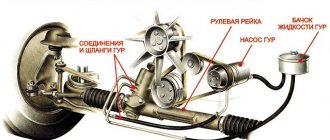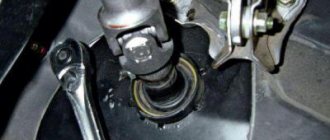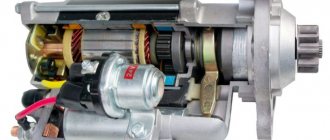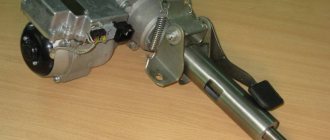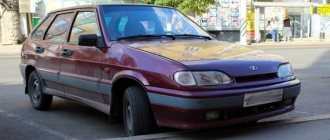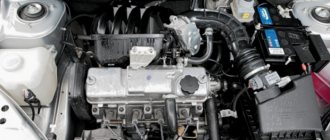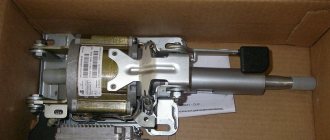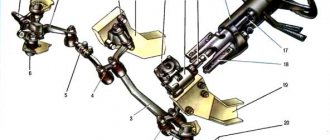Creaking when turning the steering wheel is a problem that every driver faces. Some people notice extraneous sounds immediately, others realize this after several years of continuous use of the car. Squeaks are often common causes of breakdown or malfunction of a mechanism. Problems show themselves under certain circumstances. In our case, this occurs when turning the steering wheel. Let's consider what causes exist, as well as methods for eliminating an unpleasant squeak.
Front stabilizer
If the stabilizer link partially fails, a dull knock is heard when the wheels turn while moving. Moreover, the wheels begin to knock if they are turned to one side or the other at approximately 50...60%. However, a faulty strut itself can creak not only when turning, but also when the car is moving on an uneven road. Often the car also “fidgets” on the road, that is, it is necessary to constantly control (twist) the steering wheel. Additional signs - the car body rolls too much when entering a turn and sways when braking.
Diagnosis of EUR malfunction
First of all, the main symptom of a malfunction appears in the form of a steering wheel icon with an exclamation mark on the Priora’s instrument panel. In this way, the ECU notifies the driver of problems with the power steering.
Normally, when the ignition is turned on, this icon lights up for a while and then goes out. However, if the system is faulty, the icon indicating that the Priora's electric booster is faulty will be constantly on.
As for the most common problems, the EUR power wires (red and black) may become loose or burnt. The power steering fuse also often fails. By the way, voltage drops may not be related to the amplifier. In this case, you need to check the condition of the battery and the functionality of the generator.
Let's move on. It also happens that the steering wheel icon on the panel does not light up, but the driver still notices that the EUR on the Priora does not work as it should. To quickly check, you need to turn the steering wheel with the ignition off, remembering the force. Next, start the engine, and then check the force. If the force is the same both when the engine is turned off and when the engine is running, then there is reason to believe that there are problems with the electric booster.
Causes of knocking and solutions
Diagnosis of problems with the steering wheel
- A failed ball joint. In this case, it may simply burst. This entails the wheels turning inward or outward in an unnatural way. The car is unable to move on its own. The only way out is to replace the hinge with a new one.
- A failed grenade. If a knock is heard when turning the steering wheel to the right, then the left grenade is loaded. Naturally, to solve a problem such as a knocking noise when turning the steering wheel to the left, you should replace the right grenade and vice versa.
- Wear of stabilizer bushings. To solve the problem, you need to purchase silicone grease and simply spray it on the bushings.
- Steering rack malfunction or weakening. Diagnostics will help identify the problem and repair/replace the spare part.
- Loosening the engine crankcase protection bolts . To do this, you need to tighten the bolt, or replace it if the thread is broken. It is rare that a tap needs to be used to create a new thread.
- It is possible that after replacing the wheel the nut was not tightened properly , then a knocking noise may appear after an unsuccessful replacement, and over time it increases with vibration. The solution is to tighten the nuts to the desired torque.
- Considering the quality of spare parts and the conscience of sellers, a spring can easily burst . The solution to the problem lies in replacing it with a new spring.
- Leaking shock absorbers are another reason for the appearance of a characteristic knocking sound when the car squats. Replacing with a new shock absorber will help solve this problem.
Why is grinding heard and how to deal with it
If you hear a grinding noise when you turn the steering wheel, this indicates wear on the steering system joints or front suspension. To find out the exact cause, it is worth carrying out diagnostics at a service station and replacing the failed spare part.
Article on the topic: Gasket for the fuel pump: which is better
Noise can occur when turning the steering wheel: a grinding sound when driving, or when the car is stationary. The cause of this noise lies in the failure of the support bearings of the strut or lower ball joint.
If you hear a grinding noise in the wheel when you turn the steering wheel, there can be many reasons. Experienced drivers advise contacting a car mechanic, driving the car into an inspection pit and having a look. Among the reasons are:
- The rubber on the cardan outboard bearing is torn. Stones and rubble can get into it;
- The grinding noise may occur when the pads rub against the discs;
- Another reason could be a loose locking ring.
In sub-zero weather, when turning the steering wheel all the way, a grinding noise is heard due to lack of lubrication. In this case, additional application of lubricant will help.
How to keep the EUR in working condition longer
Very often the Priora's ESD does not work and fails due to careless driving. In order for the repaired electric amplifier to work as long as possible, you should follow simple rules:
- do not leave the steering wheel in the extreme position for a long time;
- do not make sudden movements with the car when it is in an extreme position;
- when turning a car or parking it, you cannot hold the steering wheel in the extreme position for more than five seconds;
- regular scheduled inspections of the EUR;
- While driving, pay attention to extraneous sounds emanating from the electric booster.
Follow these rules, and you may not have to deal with ESD repairs for a long time.
Because you are not a trust user. How to become a trustee.
Because The topic is archived.
Because you are not a trusted user (phone number is not verified). Enter and confirm your phone number. Read more about trusts.
Because The topic is archived.
Because you are not a trusted user (phone number is not verified). Enter and confirm your phone number. Read more about trusts.
Because The topic is archived.
Because you are not a trusted user (phone number is not verified). Enter and confirm your phone number. Read more about trusts.
Because The topic is archived.
Are you too lazy to take it to a service center to diagnose the suspension if you can’t determine it yourself? How do we know how and what is creaking there? Do you yourself understand the absurdity of your question?
Because you are not a trusted user (phone number is not verified). Enter and confirm your phone number. Read more about trusts.
Because The topic is archived.
Because you are not a trusted user (phone number is not verified). Enter and confirm your phone number. Read more about trusts.
Because The topic is archived.
Because you are not a trusted user (phone number is not verified). Enter and confirm your phone number. Read more about trusts.
Because The topic is archived.
Because you are not a trusted user (phone number is not verified). Enter and confirm your phone number. Read more about trusts.
Because The topic is archived.
Because you are not a trusted user (phone number is not verified). Enter and confirm your phone number. Read more about trusts.
Because The topic is archived.
Because you are not a trusted user (phone number is not verified). Enter and confirm your phone number. Read more about trusts.
Because The topic is archived.
Because you are not a trusted user (phone number is not verified). Enter and confirm your phone number. Read more about trusts.
Because The topic is archived.
Because you are not a trusted user (phone number is not verified). Enter and confirm your phone number. Read more about trusts.
Because The topic is archived.
Other reasons
When the driver realizes that his steering wheel is creaking when turning, he begins to look for the cause. However, the malfunction may lie in different elements of the car system. Specific car brands have their own specific reasons, which are not discussed in this article. The variety of steering systems is so great that there are many causes of malfunction.
In any case, whatever the cause of the problem, it must be eliminated as soon as possible. And it will be good if a professional does this. It's best to see a mechanic as soon as you notice any warning signs that could indicate a problem with your power steering or other critical components. Underestimating minor problems can lead to their aggravation and complete destruction of the system, which is associated with expensive repairs.
Chip errors
When a situation is observed that the wheels turn on their own, the reason is the electronic filling of the Priora electric power steering control unit.
As mentioned above, quality was sacrificed for the sake of economy. Now the situation with this seems to have improved and everything has been finalized, but if suddenly you feel that the steering wheel is starting to move by itself, go for repairs. If, along with the electric power steering, the speedometer also fails, then you need to look at the speed sensor. It was either simply dirty or broken. The same applies to the torque sensor installed on the amplifier. Clean them well and check their functionality.
When the shock absorber is faulty
Sometimes the cause of the noise is the creaking of the support bearing when turning the steering wheel. If creaking and howling noises occur no matter which way you turn, check the shock absorbers. Often the problem is in the bearings of this unit. It may be enough to remove any dirt that has clogged up under the boot. How to diagnose? Read on.
Try turning the steering wheel while standing still. Even better, ask an assistant to “steer”, while you listen and watch the movement of the shock absorber spring into the gap between the upper edge of the tire and the wing arch. If the part turns jerkily, as if something is interfering with it, it means that the support bearing creaks when turning the steering wheel. It's simple. There is no movement - neither the transmission nor the hubs can make noise - the shafts and wheels do not rotate. In this case, the only thing to suspect is the shock absorber struts.
Bottom line
If it so happens that your car’s bearing is humming when turning right or left, don’t put off repairs. Contact a car repair shop. If you have the skills, you can replace the wheel bearing yourself. The main thing is to do it on time. If the hum is barely noticeable, use Suprotek tribotechnical restoring lubricant. As practice shows, in this case you can count on 10-15 thousand kilometers without much risk.
Well, when the noise intensifies, rattling or crunching sounds are added at the beginning of movement - urgently replace the bearing.
Sources
- https://shosse.ru/remont/rulevaya-sistema/chto-delat-i-kak-ispravit-esli-slyshen-skrip-i-skrezhet-pri-povorote-rulya/
- https://AvtoNov.com/%D1%81%D0%BA%D1%80%D0%B8%D0%BF-%D0%BF%D1%80%D0%B8-%D0%BF%D0%BE %D0%B2%D0%BE%D1%80%D0%BE%D1%82%D0%B5-%D1%80%D1%83%D0%BB%D1%8F/
- https://okeydrive.ru/pochemu-skripit-rul-pri-povorote-osnovnye-prichiny/
- https://DriverTip.ru/osnovy/skrezhet-ili-skrip-pri-povorote-rulya.html
- https://rad-star.ru/pressroom/articles/skrip-v-kolese-pri-povorote-rulya/
- https://howcarworks.ru/%D0%B2%D0%BE%D0%BF%D1%80%D0%BE%D1%81/%D1%81%D1%82%D1%83%D0%BA- %D1%81%D0%BA%D1%80%D0%B8%D0%BF-%D0%B8%D0%BB%D0%B8-%D0%B3%D1%83%D0%BB-%D0% BF%D1%80%D0%B8-%D0%BF%D0%BE%D0%B2%D0%BE%D1%80%D0%BE%D1%82%D0%B5-%D1%80%D1% 83%D0%BB%D1%8F-%D0%B2-%D1%87%D1%91%D0%BC-%D0%BC%D0%BE%D0%B3%D1%83%D1%82-% D0%B1%D1%8B%D1%82%D1%8C-%D0%BF%D1%80%D0%B8%D1%87%D0%B8%D0%BD%D1%8B
- https://suprotec.ru/suprotek-stati/gul-shum-podshipnika-pri-povorote-chto-delat/
- https://auto-self.ru/skrezhet-stuk-svist-slyshen-pri-povorote-rulya-v-chem-prichina-i-kak-eto-ispravit/
- https://1autoguide.ru/rulevoe-ypravlenie/pri-povorote-rulya-skripit-prichiny
- https://FB.ru/article/287237/rezinovyiy-skrip-pri-povorote-rulya-na-meste—shkoda-logan-priora-folksvagen
Causes of creaking rack and steering column
If the steering column is not working properly, you will hear a slight knock and noticeable vibration when driving. The cause of this malfunction is a strong mechanical impact on the steering wheel, during sudden braking or a collision during an accident. Such signs indicate deformation of the steering column. Also, strange sounds may come from the coupling.
Of course, the best way to eliminate a squeaking or knocking sound when moving and turning the steering column is to simply replace the non-functioning element with a new part. Unfortunately, the steering column is expensive, which means you need to look for ways to repair the old part. Vibration and noise can be eliminated using lubricant. Lubricating the driveshaft with a small amount of grease can eliminate unwanted noise, but this will only mask the symptoms. It is important to seek help from professionals who can fix the broken part before it completely fails.
Steering knuckle bearings
If, when turning the steering wheel, the driver hears an uncharacteristic squeak, which can sometimes appear quite suddenly, it is worth listening to the steering knuckle.
When the sound comes from there, the cause most likely lies in worn bearings.
These bearings can squeak and make cracking noises if there is no lubricant inside or if sand or other abrasive contaminants have entered the housing.
Untimely replacement can have dangerous consequences. It is recommended to remove the bearing from the steering knuckle and check it for defects. If they are not there, lubricant is added and the part is returned to its place. If defects are detected, a new bearing similar to the previous one is used.
Replacing the ball joint
Tool for work:
- wrenches 17, 19;
- hammer;
- mount;
- puller;
- head for 12.
The ball joint is being replaced
The car is put on the handbrake, the bolts of the wheel from which the ball joint will be removed are loosened. Using a jack, the front part of the Lada Kalina car is raised, the bolts and wheel are removed. Use a 19 wrench to unscrew the ball pin nut. Insert the puller and twist to release the support pin.
The support fastening bolts are removed using a 12mm socket. The lever is pressed down, the support is released and removed. There is another way to dismantle the ball joint: the brake disc is placed on a rigged brick, the jack is lowered slightly to relieve the lever. At this moment the rack rises up, the ball is released.
A large amount of lubricant must be added to the new support. The pin is put in place, the nut is tightened with a torque of 66-82 Nm. If the holes of the steering knuckle and the support coincide, the bolts are tightened. The procedure requires patience and considerable effort.
Problems with the steering rack
The main reason for annoying squeaking noises when turning the steering wheel is a faulty steering rack. Such a squeak can be annoying, and untimely repairs can damage the parts. Unwanted squeaking can occur due to simple wear of the mechanisms, damage to the rack box or wear of the steering tips, which can rub against the rods. In addition, damaged anthers can accumulate dirt and debris, which makes a nasty sound when the mechanism operates.
Also, the cause of an unwanted squeak may be an incorrect setting between the steering rack and the column. It is extremely difficult to make such an adjustment, since all machines have an individual adjustment system, and it is better to trust a specialist.
Repairing the EUR on-board computer
As for the “brain” and internal sensors, the procedure is as follows: to fix broken sensors, it is better to go to a service station, but you can change the computer at home. Tools that need to be used to work with the equipment:
- socket wrench 8;
- socket wrench 13;
- shaped screwdriver.
It is necessary to first remove the steering wheel.
Sounds on cars with hydraulic booster
The power steering mechanism consists of the same parts and trapezoids, only the rack has special oil channels. Through them, oil under pressure acts on the steering rods, which makes it easier to turn the wheels.
– wear of the impeller of the power steering pump itself;
– jamming of the power steering pump;
– broken boots in the steering rack (it will start to leak);
– wear of the power pump drive pulley.
This kind of trouble happens even when the steering is working properly. In a strong eversion of the wheels, the load on the power steering pump becomes large. Especially when the car is loaded. The sound occurs due to increased wear on the drive pulley or belt.
Service
In order for the steering to work properly, the driver must know how to properly maintain and operate it. To do this, you should carry out maintenance: change the oil in the power steering pump, if the tips or steering rods are worn, replace them with new ones, check the wheel alignment and adjust them if the angles do not match. Spare parts and oil must be from high-quality and original manufacturers. During operation, the driver must monitor the condition of the steering and the proper operation of the hydraulic or electric booster.
There must also be no air in the hydraulic system. This will ensure a moderate load on the device pump. Check the tightness of the bolts in the connections of the steering linkage or the mounting of the steering mechanism to the body, as well as the tightness of the electric motor or pump. If there is a lot of play on the rack, it can be tightened. But try not to overdo it. As a result, even with power steering, you will have tight and uncomfortable steering. While standing still, it is not recommended to turn the wheels too much. Do not twist them all the way. This will reduce the load on the steering rack, drive belt and pulleys, power steering pump or electric motor. Also, after turning the car’s wheels in place, you should not move away abruptly and rev the engine. This significantly accelerates the wear of steering parts. In addition, the service life of constant velocity joints will be reduced if the car is front-wheel drive. If the mechanism uses a cardan drive, it is recommended to periodically lubricate the joints. This is done by extrusion. Litol universal lubricant is used. It can be used for injection of car king pins if the design uses an independent beam at the front.
Tie rods and tie rods
Due to natural wear and tear, the lugs and rods may, over time, become loose and squeak and make knocking noises when turning the machine. To diagnose, you need to jack up the car on the side where the annoying sound is coming from and first remove the wheel. Next, you need to shake the rods and tips and check for any play in them. It often happens that the boot on the tip breaks, which means dirt and moisture gets inside. This causes a corresponding knock.
There are cases when, for example, when performing a wheel alignment operation, a car enthusiast or master forgets to tighten the fastening nut between the steering rod and the steering tip. Accordingly, when you turn the steering wheel, both in motion and at a standstill, a loud metallic knock will be heard. You can determine more precisely if you shake the front wheel left and right with your hands, it will dangle and make similar sounds.
Wheel alignment
Let's start with a fairly common reason due to which a grinding noise is heard from the wheels when turning the steering wheel of a car while driving or in a parking lot.
If the sound comes from there, then there is a high probability that there are no problems with the steering. But the wheels are positioned incorrectly. When problems appear after a wheel alignment, it was probably simply done incorrectly.
If you set the front axle wheels incorrectly, the tires will begin to wear out quickly and unevenly.
Most often, such a nuisance occurs among those who save on car service and decide to carry out the wheel alignment themselves.
Here it is better to visit a service station, perform computer diagnostics and carry out professional balancing.
Elimination method
The method for eliminating squeaks when turning the steering wheel is quite simple. First you need to find the cause and element that makes extraneous sounds. If the outer hinges are worn, they should be replaced. If the front wheel bearings are worn out or the hub nut is loosened, these fasteners must be tightened and the bearings replaced.
In cases where a spring creaks when turning the steering wheel in different directions, it means that it is broken. It needs to be replaced, and it is advisable to do it in pairs at once.
If the steering wheel, steering column bracket, steering mechanism, rack adjusting bolt, steering rod ball pins, or bolts securing the lower flange of the elastic coupling on the gear shaft make knocking noises when turning the steering wheel due to loose fastening, then tighten the threaded connections and adjust the steering column.
Common causes of squeaking noise when turning the steering wheel
Here are the most common reasons why you hear a squeak when turning the steering wheel.
Wheel alignment performed incorrectly
If you hear squeaking noises from your tires, and it mostly happens when the car is stationary, there is a good chance that the problem is due to improper wheel alignment. In this case, it is necessary to perform a wheel alignment as quickly as possible to correct the problem.
Incorrect wheel alignment angles negatively affect the tires, which begin to wear unevenly and fail much faster than they should.
Silent blocks creak
A common problem that is often encountered in hot weather. If silent blocks begin to creak at high ambient temperatures, this is the first “bell” that they will soon fail.
The creaking of silent blocks in hot weather is due to their drying out. Since the main working material of silent blocks is rubber, at high temperatures it “dries out” and decreases in size, especially if we are talking about relatively old parts.
There is no danger in the creaking of silent blocks until the part breaks. Remove the silent blocks and carefully inspect them for cracks and various types of damage. If there are no visible problems, you can put them in place and continue driving, hoping that soon the air temperature will drop lower and the squeak will disappear.
Please note: For many modern cars you can find silent blocks made of polyurethane, which is not subject to the problem of “drying out” in the heat.
Bearings squeak
If you hear a squeaking, squeaking, or crackling sound from the steering knuckle when you turn the steering wheel, this most likely indicates a bearing problem. They behave in a similar way if there is not enough lubrication for their proper operation or if there is sand (or other foreign element) in the bearing.
Bearing creaking must be eliminated as quickly as possible so that the part does not fail completely. To do this, remove the bearing and inspect it for damage. If they are not found, then lubricate the part, install it in place and adjust.
Please note: When the squeaking of a bearing is caused by foreign elements entering it, be sure to find the reason for their entry into the part.
Steering rack or steering column creaks
It is quite simple to determine the creaking of the steering column by the characteristic vibration, which will also occur when the steering wheel rotates. Most often, the steering column clutch squeaks, and this problem is typical for cars that were unsuccessfully restored after a serious accident. This problem, if the noise is not strong, does not affect the quality of the steering mechanism, so you can continue to operate the car. The situation can only be corrected by replacing the steering column.
Also, a squeak can be heard from the steering rack and column joint if they are poorly adjusted or there is severe wear. Depending on the car model, this problem can be solved in different ways. Most often it is possible to adjust the mechanism.
Tie rod ends squeak
Due to damage to the anthers, foreign elements get into the tie rod end pin, which leads to squeaks both when turning the steering wheel and when overcoming obstacles. To determine if there is a problem, you need to inspect the tips, and if sand or other foreign matter actually got into them, you will need to replace them, and it is recommended to change them in pairs.
The plastic casing creaks
Every driver knows that when actively using a car that is not of the best build, “crickets” will appear over time. They represent creaks of the front panel, including the steering casing, made of plastic. This problem is solved in various ways, depending on the car model.
If all the parts described above have been inspected and the cause of the squeak cannot be determined, it is also recommended to check the power steering drive belt and brake elements, especially the pads and discs.
Major failures of the EUR
Experienced drivers and Prior owners can observe the following trend - breakdowns occur in the same parts, weak points of the system. Why is this happening?
The first thing you need to pay attention to is the operation of the electric power steering. After the system has been completely turned off, a code should appear on the on-board computer - it reports the cause of the breakdown. Each code has its own interpretation. However, very often the real reason for the cessation of operation of the amplifier can be determined only after a full diagnosis has been carried out. In order to find out about the nature of the breakdown of the Lada Priora electric power steering, do the following:
- The engine is turned off and the steering wheel is turned a couple of times.
- The engine turns on and the steering wheel turns several times.
It is quite possible to drive with the system turned off, but it is not recommended. It is very difficult to understand the features of control with and without an electric booster. Therefore, it is better to perform a diagnosis. It will help determine which component has failed, whether it can be repaired or whether it is better to replace it with a new one.
Sometimes you can observe the following situation: the speedometer and the sensor stop functioning at the same time. This most often occurs due to a malfunction of the speed sensor. The sensor provides data to the control unit, which processes the information on the speedometer and determines the supply of the required amount of force.
If the cause of the breakdown is the sensor, the solution to the problem is simple. It is enough to check the quality of the wires and, if necessary, replace them with new ones. If the wires are in good condition, it is recommended to replace the sensor itself.
Fuse removal process
If, during smooth and smooth movement forward, the car turns sharply to the side, it is recommended to carry out unscheduled diagnostics. After all, such unpredictable behavior of the Priora’s electric power steering will not happen without emergency situations. Park and unplug the unit: Disconnect the fuse to stop power supply to the amplifier.
To remove the fuse, you need to do the following:
A car malfunction indicates problems with the ESD. There can be many reasons for this, the breakdown of one part or several. To determine the cause as accurately as possible, seek specialized diagnostics. And you can replace or repair a damaged part yourself.
The process of removing the electric amplifier
If you decide to replace the electric power steering on a Prior car or make sure that its individual parts are in working condition, you need to remove the unit completely. For this you will need:
- chisel;
- head for 8 or 13;
- extension;
- ratchet.
The process of removing the EUR is simple and fast. The process is lengthy: you need to remove the steering wheel, grab the airbag, then remove the cover and finally, the ignition switch. After all this, you can take out the electric amplifier.
Noises from power steering
Despite the fact that electric power steering is being introduced very often today, the main driver assistant when steering in most passenger cars remains power steering. This unit may make noise due to a lack of working fluid. In this case, you need to add it to a tank specially designed for this purpose. Just add the same liquid that the manufacturer used, the amplifier itself is configured specifically for the operating parameters of a particular product, and the use of a different liquid can be very negatively perceived by the amplifier. In addition to the lack of working fluid, the cause of noise in the power steering can be its pump, if it is about to die, you also need to check the condition of the power steering belt, because certain difficulties can also arise with it. And if the condition of the power steering belt makes you suspicious, it is better to replace the belt.
: when braking in a car - why and what to do?
Battery problems
Based on this, we can draw the first conclusions about the cause of the breakdown. A common cause of malfunction is low voltage in the on-board network. The fact is that for the amplifier to function, a supply voltage of 13.5V is required.
First of all, we test the battery, if everything is fine with it, then we’ll look into it further. The problem may have occurred when you removed the battery for charging. To make the electric booster work again, turn the wheels to the extreme position and back 5-6 times, very often this is enough to resume operation.
When turning the steering wheel, a grinding noise is heard in the wheel area
What could be the reason
When you hear squeaks, grinding noises, or crunching noises from a wheel when turning, this may be due to one of the following reasons:
- Due to long-term use, the steering rack wears out. It is possible that the noise is due to the fact that the fastening is loose.
- This result is caused by a faulty steering column.
- If the shock strut bearings need replacing or have bad ball joints, this is also a possible cause of the noise.
- The drive mechanism must operate in clean conditions, but if the anthers rupture, dirt will get inside and disrupt its operation.
